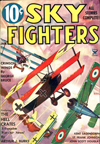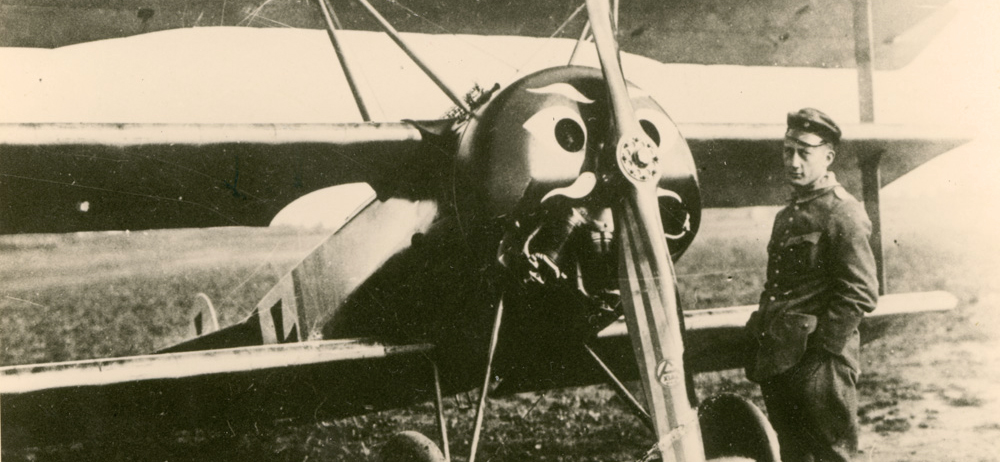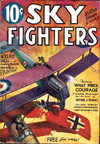AMIDST all the great pulp thrills and features in Sky Fighters, they ran a true story feature collected by Ace Williams wherein famous War Aces would tell actual true accounts of thrilling moments in their fighting lives! This time we have British Flyer Major Edward Mannock’s most thrilling sky fight!
Edward “Micky” Mannock was serving 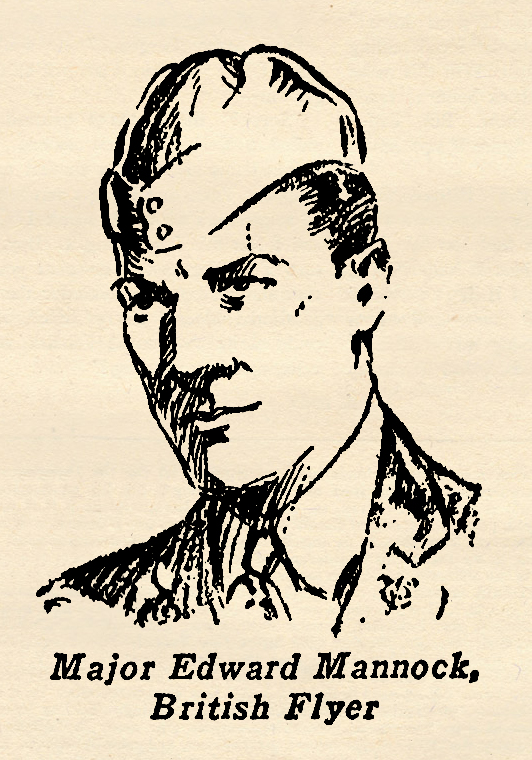 the British postal department, Turkey, when the war broke out. He was immediately made a prisoner by the Turks, and spent almost a year in an enemy camp before he was repatriated to England in 1915. He first served in the Royal Engineers, was commissioned as a lieutenant and transferred to the flying Corps in August, 1916. Major McCudden, the great British Ace, was his first instructor.
the British postal department, Turkey, when the war broke out. He was immediately made a prisoner by the Turks, and spent almost a year in an enemy camp before he was repatriated to England in 1915. He first served in the Royal Engineers, was commissioned as a lieutenant and transferred to the flying Corps in August, 1916. Major McCudden, the great British Ace, was his first instructor.
At the end of the war Mannock ranked as the British Ace of Aces, with 76 victories to his credit, more than Bishop, Ball, or McCudden himself. Flying a Nieuport Scout he downed his first Hun June 7th, 1917. On July 25th, 1918, he got his 76th victory in an S.E.5. The next day he was seen to fall in flames behind the enemy lines. Before he was killed he was awarded the D.S.O. and the M.C, and was swiftly promoted to to the rank of Major. He was awarded the Victoria Cross posthumously. The following account of his fight with do enemy aircraft is taken from the report of a British journalist.
ONE AGAINST FORTY
by Major Edward Mannock • Sky Fighters, November 1935
I HAVE seldom been taken by surprise in the air. “Jimmy” McCudden schooled me well on that score in my early flight training. But one time I did get caught good and plenty. Forty Huns plopped in on me at once. I was flying solo over Villers-Bretteneux. It was a bad day for flying. There was rain and low-hanging clouds. The Huns had a big landing field at Villers, but our bombers had played it hot and heavy, and word came through to us that the Huns had abandoned it.
Right over the field there was a big hole in the clouds, so I dropped down for a look-see to ascertain the truth of the report. The field and hangars looked deserted. There was not an E.A. in sight. I dived low, got beneath the cloud layer. Then I saw why the field looked deserted. I had had the ill luck to drop down through that hole in the clouds just as the Hun staffels were leaving. Four flights of Huns had just left the ground, and were circling just beneath the clouds. The intervening clouds had hidden them from my view. When I did see them, it was too late for me to make my escape into the protecting clouds, for the Huns slid over on top of me.
There was nothing else for me to do but fight my way out of the trap.
Lead was rattling into my turtleback before I had a chance to shift into a climbing turn and bring my guns to bear upon any of the enemy. And one burst of slugs knocked my helmet askew so that my goggle glasses were wrenched across my eyes, blurring my vision.
When I did get them in place again, a purple-nosed Hun was diving at me head-on, both his Spandaus spewing out blue white streams. I maneuvered, pressed my trigger trips, then went up on one wing and slid down in an abrupt sideslip. The Hun ship shattered above me, exploded in flames. The blazing ship just missed mine as I nosed out of the slip. By now all the Hun planes had closed in tight on me.
But the Huns made one error. They hemmed me in so tight on all sides, above and below, that they couldn’t use their guns advantageously. I got two more of my attackers. But cheered as I was when I saw the E.A.5s fall, I knew that I couldn’t hold out against them for long. If I could pull up into the clouds, I knew I could lose them. Getting there was the problem. I went into a steep power dive, letting all that wanted to get on my tail. After a thousand foot dive, I pulled back on the stick and shot straight for the clouds.
Bullets raked my S.E. all the way down and up, but none of them had my name and address. I was just plain lucky, I guess, for I managed to make the clouds without getting popped. Once in them, I straightened out for my lines with all the sauce on. Believe me, my own airdrome looked good when I sat down there. I had got three of the full forty I had tangled with, but I didn’t regret not staying for more.








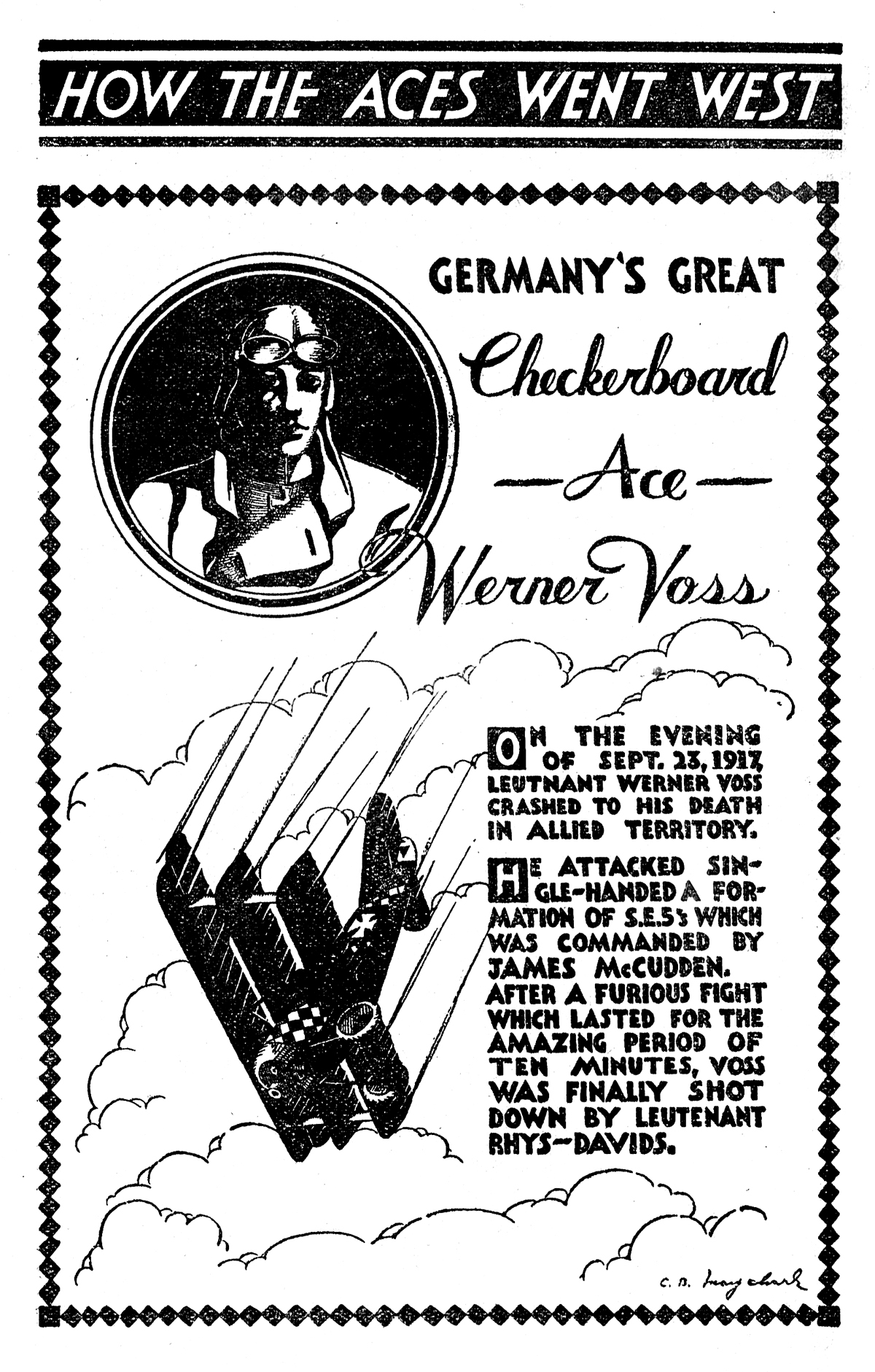
 the British postal department, Turkey, when the war broke out. He was immediately made a prisoner by the Turks, and spent almost a year in an enemy camp before he was repatriated to England in 1915. He first served in the Royal Engineers, was commissioned as a lieutenant and transferred to the flying Corps in August, 1916. Major McCudden, the great British Ace, was his first instructor.
the British postal department, Turkey, when the war broke out. He was immediately made a prisoner by the Turks, and spent almost a year in an enemy camp before he was repatriated to England in 1915. He first served in the Royal Engineers, was commissioned as a lieutenant and transferred to the flying Corps in August, 1916. Major McCudden, the great British Ace, was his first instructor.